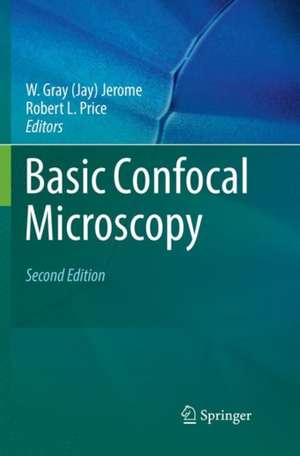Basic Confocal Microscopy
Editat de W. Gray (Jay) Jerome, Robert L. Priceen Limba Engleză Paperback – 30 ian 2019
| Toate formatele și edițiile | Preț | Express |
|---|---|---|
| Paperback (2) | 999.94 lei 6-8 săpt. | |
| Springer – 23 aug 2016 | 999.94 lei 6-8 săpt. | |
| Springer International Publishing – 30 ian 2019 | 1222.49 lei 6-8 săpt. | |
| Hardback (1) | 1227.84 lei 6-8 săpt. | |
| Springer International Publishing – 12 noi 2018 | 1227.84 lei 6-8 săpt. |
Preț: 1222.49 lei
Preț vechi: 1490.84 lei
-18% Nou
Puncte Express: 1834
Preț estimativ în valută:
233.100€ • 254.26$ • 196.68£
233.100€ • 254.26$ • 196.68£
Carte tipărită la comandă
Livrare economică 21 aprilie-05 mai
Preluare comenzi: 021 569.72.76
Specificații
ISBN-13: 9783030073589
ISBN-10: 3030073580
Pagini: 368
Ilustrații: XI, 368 p. 189 illus., 149 illus. in color.
Dimensiuni: 155 x 235 mm
Greutate: 0.58 kg
Ediția:Softcover reprint of the original 2nd ed. 2018
Editura: Springer International Publishing
Colecția Springer
Locul publicării:Cham, Switzerland
ISBN-10: 3030073580
Pagini: 368
Ilustrații: XI, 368 p. 189 illus., 149 illus. in color.
Dimensiuni: 155 x 235 mm
Greutate: 0.58 kg
Ediția:Softcover reprint of the original 2nd ed. 2018
Editura: Springer International Publishing
Colecția Springer
Locul publicării:Cham, Switzerland
Cuprins
Chapter 1 Introduction and Historical Perspective.- Chapter 2 The Theory of Fluorescence.- Chapter 3 Fluorescence Microscopy.- Chapter 4 Specimen Preparation.- Chapter 5 Labeling Considerations for Confocal Microscopy.- Chapter 6 Digital Imaging.- Chapter 7 Confocal Digital Image Capture.- Chapter 8 Types of Confocal Instruments: Basic Principals and Advantages and Disadvantages.- Chapter 9 Setting the Operating Parameters.- Chapter 10 3D Reconstruction of Confocal Image Data.- Chapter 11 Analysis of Image Similarity and Relationship.- Chapter 12 Ethics and Resources.
Notă biografică
Dr. W. Gray (Jay) Jerome is an Associate Professor of Pathology, Microbiology and Immunology at Vanderbilt University School of Medicine. He has published extensively on microscopy of biological material. His work involves correlating microscopic structural information with biochemical, physiological, and molecular genetic data to provide a comprehensive picture of structure-function relationships. Dr. Jerome is a Fellow of the Microscopy Society of America, a Fellow of the American Association for the Advancement of Science, a Fellow of the American Heart Association and a Past-President of the Microscopy Society of America.
Dr. Robert L. Price is a Research Professor in Cell Biology and Anatomy at the University of South Carolina School of Medicine and Director of the Instrumentation Resource Facility. He has been active in biomedical imaging using confocal microscopy since 1990 and along with Dr. Jerome has taught numerous Confocal Workshops in the United States and Australia. Dr. Price has received several awards from the University of South Carolina and the Microscopy Society of America, is a Fellow of the Microscopy Society of America, and currently President of the Microscopy Society of America.
Dr. Robert L. Price is a Research Professor in Cell Biology and Anatomy at the University of South Carolina School of Medicine and Director of the Instrumentation Resource Facility. He has been active in biomedical imaging using confocal microscopy since 1990 and along with Dr. Jerome has taught numerous Confocal Workshops in the United States and Australia. Dr. Price has received several awards from the University of South Carolina and the Microscopy Society of America, is a Fellow of the Microscopy Society of America, and currently President of the Microscopy Society of America.
Textul de pe ultima copertă
Basic Confocal Microscopy, Second Edition builds on the successful first edition by keeping the same format and reflecting relevant changes and recent developments in this still-burgeoning field. This format is based on the Confocal Microscopy Workshop that has been taught by several of the authors for nearly 20 years and remains a popular workshop for gaining basic skills in confocal microscopy. While much of the information concerning fluorescence and confocal microscopy that made the first edition a success has not changed in the six years since the book was first published, confocal imaging is an evolving field and recent advances in detector technology, operating software, tissue preparation and clearing, image analysis, and more have been updated to reflect this. Several of these advances are now considered routine in many laboratories, and others such as super resolution techniques built on confocal technology are becoming widely available.
Caracteristici
Fully updated and expanded to reflect developments in the field yet still concise and comprehensive Covers the basics needed to design, implement, and interpret the results of biological experiments based on confocal microscopy, as well as resources for continued learning All chapters are written by well-recognized experts in the field While not a traditional textbook, this is the perfect companion volume for the Confocal Microscopy Workshops presented regularly by the authors and others
Recenzii
From the reviews:
“This is an eleven chapter’s effort done by a bunch of Authors coordinated by Prof. R.L. Price and W.G. Jerome … that with great skills are revealing us the secrets of confocal microscopy. … The chapters devoted to the conversion of analogic into digital data make the book particularly valuable. … Definitely an excellent book, a must for the microscopists and anyone who is using a microscope and/or is studying biology.” (Manuela Monti, European Journal of Histochemistry, Vol. 56 (1), 2012)
“This is an eleven chapter’s effort done by a bunch of Authors coordinated by Prof. R.L. Price and W.G. Jerome … that with great skills are revealing us the secrets of confocal microscopy. … The chapters devoted to the conversion of analogic into digital data make the book particularly valuable. … Definitely an excellent book, a must for the microscopists and anyone who is using a microscope and/or is studying biology.” (Manuela Monti, European Journal of Histochemistry, Vol. 56 (1), 2012)
